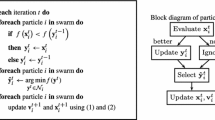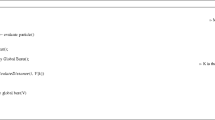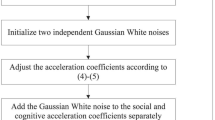Abstract
Particle swarm optimization (PSO) is a population-based algorithm designed to find good solutions to optimization problems. However, if the problems are subject to noise, the quality of its results significantly deteriorates. Previous works have addressed such a deterioration by developing noise mitigation mechanisms to target specific issues such as handling the inaccurate memories of the particles and aiding the particles to correctly select their neighborhood best solutions. However, in spite of the improvements achieved, it still remains uncertain the extent to which these issues affect the particles, and the underlying reasons for the deterioration of the quality of the results. In this article, we formally define deception, blindness and disorientation as the conditions responsible for such a deterioration, and we develop a set of population statistics to measure the extent to which these conditions affect the particles throughout the search process. The population statistics are computed for the regular PSO algorithm and for PSO with equal resampling (PSO-ER) on 20 large-scale benchmark functions subject to different levels of multiplicative Gaussian noise. The key findings that we reveal with the population statistics on optimization problems subject to noise are the following: (a) the quality of the results significantly deteriorates as particles suffer from large proportions of deception and blindness; (b) the presence of deception, blindness and disorientation, and their effects on the quality of results, makes the performance of the swarms sensitive to optimization problems subject to noise; (c) the incorporation of resampling methods into PSO significantly improves the quality of the results; and (d) it is better to first address the conditions of blindness and disorientation before addressing deception.






Similar content being viewed by others
References
Bartz-Beielstein, T., Blum, D., & Branke, J. (2007). Particle swarm optimization and sequential sampling in noisy environments (pp. 261–273)., Metaheuristics, operations research/computer science interfaces series Heidelberg: Springer.
Bartz-Beielstein, T., Lasarczyk, C., & Preuss, M. (2005). Sequential parameter optimization. Proceedings of the IEEE congress on evolutionary computation, 1, 773–780.
Chen, C. H., Lin, J., & Chick, S. E. (2000). Simulation budget allocation for further enhancing the efficiency of ordinal optimization. Journal of Discrete Event Dynamic Systems: Theory and Applications, 10(3), 251–270.
Clerc, M., & Kennedy, J. (2002). The particle swarm-explosion, stability, and convergence in a multidimensional complex space. IEEE Transactions on Evolutionary Computation, 6(1), 58–73.
Cui, X., Charles, J. S., & Potok, T. E. (2009). A simple distributed particle swarm optimization for dynamic and noisy environments. Nature inspired cooperative strategies for optimization, studies in computational intelligence (Vol. 236, pp. 89–102). Berlin: Springer.
Cui, X., Hardin, C. T., Ragade, R. K., Potok, T. E., & Elmaghraby, A. S. (2005). Tracking non-stationary optimal solution by particle swarm optimizer. Proceedings of the 6th international conference on software engineering (pp. 133–138). Networking and Parallel/Distributed Computing, IEEE, Piscataway, NJ: Artificial Intelligence .
Cui, X., & Potok, T. E. (2007). Distributed adaptive particle swarm optimizer in dynamic environment. Proceedings of the IEEE international parallel and distributed processing symposium (pp. 1–7). Piscataway, NJ: IEEE.
Dorigo, M., & Stüzle, T. (2004). Ant colony optimization. Cambridge, MA: MIT Press.
Eberhart, R., & Kennedy, J. (1995). A new optimizer using particle swarm theory. Proceedings of the 6th international symposium on micro machine and human science (pp. 39–43). Piscataway, NJ: IEEE.
Engelbrecht, A. P. (2006). Fundamentals of computational swarm intelligence. Chichester, West Sussex: Wiley.
Fernandez-Marquez, J. L., & Arcos, J. L. (2009). An evaporation mechanism for dynamic and noisy multimodal optimization. Proceedings of the genetic and evolutionary computation conference (pp. 17–24). New York, NY: ACM.
Fernandez-Marquez, J. L., & Arcos, J. L. (2010). Adapting particle swarm optimization in dynamic and noisy environments. Proceedings of the IEEE congress on evolutionary computation (pp. 1–8). Piscataway, NJ: IEEE.
Holland, J. H. (1992). Adaptation in natural and artificial systems: An introductory analysis with applications to biology. Control and artificial intelligence. Cambridge, MA: MIT Press.
Jin, Y., & Branke, J. (2005). Evolutionary optimization in uncertain environments - a survey. IEEE Transactions on Evolutionary Computation, 9(3), 303–317.
Kennedy, J., & Mendes, R. (2002). Population structure and particle swarm performance. Proceedings of the IEEE congress on evolutionary computation (pp. 1671–1676). Piscataway, NJ: IEEE.
Pan, H., Wang, L., & Liu, B. (2006). Particle swarm optimization for function optimization in noisy environment. Applied Mathematics and Computation, 181(2), 908–919.
Parsopoulos, K. E., & Vrahatis, M. N. (2001). Particle swarm optimizer in noisy and continuously changing environments. Artificial Intelligence and Soft Computing (pp. 289–294). Anaheim, CA: IASTED/ACTA Press.
Parsopoulos, K. E., & Vrahatis, M. N. (2002). Particle swarm optimization for imprecise problems. Scattering and biomedical engineering, modeling and applications (pp. 254–264). Singapore: World Scientific.
Pietro, A. D. (2007). Optimising evolutionary strategies for problems with varying noise strength. PhD thesis, The University of Western Australia, Crawley, WA.
Piperagkas, G. S., Georgoulas, G., Parsopoulos, K. E., Stylios, C. D., & Likas, A. C. (2012). Integrating particle swarm optimization with reinforcement learning in noisy problems. Proceedings of the genetic and evolutionary computation conference (pp. 65–72). New York, NY: ACM.
Poli, R. (2008). Analysis of the publications on the applications of particle swarm optimisation. Journal of Artificial Evolution and Applications, 4, 1–10.
Poli, R., Kennedy, J., & Blackwell, T. (2007). Particle swarm optimization. Swarm Intelligence, 1, 33–57.
Price, K. V., Storn, R. M., & Lampinen, J. A. (2005). Differential evolution: A practical approach to global optimization., Natural computing series Berlin: Springer.
Rada-Vilela, J., Zhang, M., & Seah, W. (2012a). Evaporation mechanisms for particle swarm optimization. Proceedings of the international conference on simulated evolution and learning (pp. 238–247). Berlin: Springer.
Rada-Vilela, J., Zhang, M., & Seah, W. (2012b). A performance study on the effects of noise and evaporation in particle swarm optimization. Proceedings of the IEEE congress on evolutionary computation (pp. 873–880). Piscataway, NJ: IEEE.
Rada-Vilela, J., Zhang, M., & Johnston, M. (2013a). Optimal computing budget allocation in particle swarm optimization. Proceedings of the genetic and evolutionary computation conference (pp. 81–88). New York, NY: ACM.
Rada-Vilela, J., Zhang, M., & Johnston, M. (2013b). Resampling in particle swarm optimization. Proceedings of the IEEE congress on evolutionary computation (pp. 947–954). Piscataway, NJ: IEEE.
Rada-Vilela, J., Zhang, M., & Seah, W. (2013c). A performance study on synchronicity and neighborhood size in particle swarm optimization. Soft Computing, 17(6), 1019–1030.
Shi, Y., & Eberhart, R. (1998). A modified particle swarm optimizer. Proceedings of the IEEE world congress on computational intelligence (pp. 69–73). Piscataway, NJ: IEEE.
Tang, K., Li, X., Suganthan, P. N., Yang, Z., Weise, T. (2009). Benchmark Functions for the CEC’2010 Special Session and Competition on Large-Scale Global Optimization. Tech. rep., Nature Inspired Computation and Applications Laboratory, University of Science and Technology of China, Hefei, Anhui, http://nical.ustc.edu.cn/cec10ss.php.
Van den Bergh, F. (2002). An analysis of particle swarm optimizers. PhD thesis, University of Pretoria, South Africa.
Zhang, S., Chen, P., Lee, L. H., Peng, C. E., & Chen, C. H. (2011). Simulation optimization using the particle swarm optimization with optimal computing budget allocation. Proceedings of the winter simulation conference (pp. 4298–4309). Piscataway, NJ: IEEE.
Acknowledgments
We are very grateful to the referees and the editor for the importance, relevance and quality of their comments, suggestions and corrections on this article.
Author information
Authors and Affiliations
Corresponding author
Electronic supplementary material
Below is the link to the electronic supplementary material.
Rights and permissions
About this article
Cite this article
Rada-Vilela, J., Johnston, M. & Zhang, M. Deception, blindness and disorientation in particle swarm optimization applied to noisy problems. Swarm Intell 8, 247–273 (2014). https://doi.org/10.1007/s11721-014-0098-y
Received:
Accepted:
Published:
Issue Date:
DOI: https://doi.org/10.1007/s11721-014-0098-y




